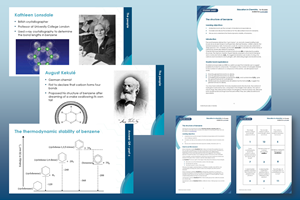Chemists use the term aromatic to describe the whole family of substances chemically related to benzene
The word benzene derives from ‘gum benzo’, an aromatic (sweet smelling) resin known since ancient times in Southeast Asia. Michael Faraday, a British scientist, first isolated benzene in 1825. It is found in crude oil, coal tar and was also detected in deep space in 1997.
Learning Objectives
- Understand and use the concept of double bond equivalence.
- Consider and discuss the evidence for the delocalised π-bond in benzene.
- Discuss and understand the thermodynamic stability of benzene.
Introduction
Chemists first knew benzene’s empirical formula was CH but debated its possible structures. The German chemist, August Kekulé, proposed a structure for benzene and a molecular formula, C6H6. He suggested benzene was made of a ring of six carbons each bonded to one hydrogen, with alternating single and double bonds.
Double bond equivalence
Double bond equivalence (DBE) is a useful concept that chemists use to suggest possible structures for compounds. It is based on the number of hydrogens relative to the number of carbons in a compound.
The first set of questions on the worksheet explore how DBE works and then links it to Kekulé’s proposed structure of benzene.
Revisiting the structure of benzene
Kekulé’s structure was adopted by the chemical community for many years. However, scientific models are constantly subject to challenge and evidence emerged that questioned Kekulé’s proposal. In 1929 Kathleen Lonsdale used x-ray crystallography to determine the bond lengths in the actual structure of benzene. For clarity in this resource we have named Kekulé’s proposed structure cylohexa-1,3,5-triene.
How to use this resource
Instruct learners to tackle Questions 1–6 on the student worksheet in class or at home. The questions focus on the concept of double bond equivalence and link it to the structure of benzene as proposed by Kekulé. Question 6 is open-ended with built in differentiation depending on how many alternative structures are suggested. Get confident learners to tackle the stretch and challenge question at the end of the worksheet.
Once complete, use the PowerPoint to talk about how the model has evolved and introduce the idea of the 6-centre 6-electron delocalised π-bond.
Use Question 7 once you get to the stage of discussing the evidence of bond length.
- Print and cut out the information cards on the last two pages of the teacher notes.
- Put learners into groups.
- Give each group a copy of the cards.
Introduce the largely overlooked figure of Kathleen Lonsdale, who did the x-ray crystallography showing the carbon–carbon bond lengths are all the same in benzene.
More resources
- Use the microscale synthesis of azo dyes as a quick practical to reinforce the link between aromatics and chromophores. In this experiment, students prepare an azo dye and use it to dye a piece of cotton.
- Find more question on aromatic chemistry in this Starter for 10 activity.
- Check and revise understanding of organic chemistry with this multiple-choice Organic synthesis quiz.
- For more context, this science research news story explores benzene reactions in fizzy drinks.
- Watch Qualitative tests for organic functional groups, before carrying out an investigative practical experiment.
Instruct learners to attempt Question 8 in their groups. Ask them to construct an energy level diagram to show the evidence from enthalpies of hydrogenation. The answers to each part (a), (b) etc are shown on slides 6–9 of the PowerPoint. Check understanding before moving on to the next part.
Get learners to discuss Questions 9–11 in their smaller groups then clarify the answers as a whole class.
Ask learners to discuss Questions 12–14, a reflection task, in their groups or as a whole class.
Answers
Answers to all of the questions in the worksheet and the stretch and challenge question are provided in the teacher notes.
Downloads
Structure of benzene student sheet
Handout | PDF, Size 0.27 mbStructure of benzene classroom slides
Presentation | PDF, Size 1.62 mbStructure of benzene teacher notes
Handout | PDF, Size 0.38 mbStructure of benzene student sheet
Editable handout | Word, Size 4.88 mbStructure of benzene classroom slides
Presentation | PowerPoint, Size 3.29 mbStructure of benzene teacher notes
Editable handout | Word, Size 4.55 mb



















No comments yet